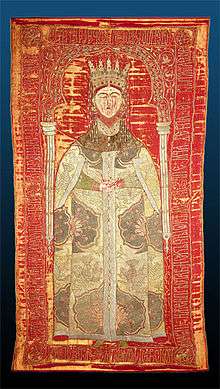Maria of Mangup

Maria Asanina Palaiologina (Greek: Μαρία Ασανίνα Παλαιολογίνα, d. 19 December 1476/1477), better known as Maria of Mangup or Maria of Doros, was the second wife of Prince Stephen the Great (r. 1457–1504) and a Princess consort of the Principality of Moldavia (1472–1477).
A descendant of imperial Bulgarian and Byzantine dynasties, Maria belonged to the ruling class of the small Crimean Principality of Theodoro. Stephen likely married her for political reasons, hoping to conquer the principality, though he lost interest in her when that proved impossible. Her elaborate burial shroud featuring her portrait is preserved in the Romanian Putna Monastery where she was buried.
Biography
A daughter of the ruler of the Principality of Theodoro (or "Gothia") in the Crimea, on her mother's side she was a descendant of two imperial houses, the Palaiologos dynasty of the Byzantine Empire and the Asen dynasty of the Second Bulgarian Empire, and on her father's side she descended from the Gabras aristocratic family of Byzantium.[1]
Maria of Mangup was a daughter of the Prince of Theodoro. It is uncertain whether her father was Olubei or his direct predecessor John, who was married to a Maria Tzamplakina Palaiologina Asanina.[1] Alexander Vasiliev considers her to have been a sister of Isaac, who was probably Olubei's son.[2] Maria of Mangup's parents left for Trebizond in 1446/7, which leaves her apparent presence in Mangup until her move to Suceava and marriage unexplained.[1]
Maria of Mangup arrived in Moldavia on 4 September 1472[2] and married Stephen the Great[3] on 14 September, likely for political reasons.[4] Vasiliev believes Stephen, a powerful ruler and "Athlete of Christ", married Maria in order to be able to lay claim on the throne of Byzantium should Constantinople be retaken from the Ottoman Turks.[2] The couple had two daughters, though Maria appears to have been largely ignored by her husband and led an unhappy family life until her death five years later.[1] According to Vasiliev, Stephen lost any interest in Maria once Theodoro was conquered by the Ottomans in 1475 and he had abandoned his hopes of capturing the Crimean principality.[5]
An undated inscription in the katholikon (main church) of the Osiou Gregoriou monastery on Mount Athos signifies that "the most pious Maria Asanina Palaiologina, lady of Moldovlachia" prayed there during her time as Princess consort.[6][7]
Maria of Mangup died in late 1476 or 1477. Stephen then married his third wife Maria Voichița, daughter of Radu III the Handsome of Wallachia.[5]
Burial shroud
Maria of Mangup was buried in the Putna Monastery in modern northeastern Romania. Her elaborate burial shroud is preserved in the monastery's treasury[7] and bears the following inscription,[6] embroidered in Cyrillic:[4]
| “ | † This is the grave cover of the servant of our Lord, of the pious and Christ-loving Maria, wife of the voivode of the country Moldavia, who entered the eternal abode in the year 6985 [1476 or 1477], December nineteenth, on a Friday, about the fifth hour of the day. | ” |
The embroidery features two monograms reading "Asanina" and "Palaiologina" and two double-headed eagles, a symbol of Byzantium, in each of the four corners. The shroud, sewn of red silk and with gold thread embroidery, depicts the Princess consort lying within an arch in her tomb in a blue-grey ceremonial garment decorated with stylized flowers and a high crown and pendants on her head.[1][5][7]
Diez considers this to be the earliest burial shroud portrait discovered in a Romanian monastery[4] as well as "harmonious" and "the most beautiful one in the group" he analyzed.[8] The shroud measures 1.88 by 1.02 metres (6.2 by 3.3 feet) and stylistically belongs to Byzantine art, though with some Western influences.[1]
References
Sources
| Wikimedia Commons has media related to Maria Asanina Paleologhina. |
- Божилов, Иван (1994). Фамилията на Асеневци (1186–1460). Генеалогия и просопография [The Family of the Asens (1186–1460). Genealogy and Prosopography] (in Bulgarian). София: Издателство на Българската академия на науките. ISBN 954-430-264-6.
- Diez, Ernst (June 1928). "Moldavian Portrait Textiles". The Art Bulletin. College Art Association. 10 (4).
- Gorovei, Ştefan S. (2006). "Maria Asanina Paleologhina, doamna Moldovlahiei (II)". Studies and Materials of Medieval History (Studii şi Materiale de Istorie Medie (SMIM)) (in Romanian). Bucharest: Nicolae Iorga Institute of History (XIV). ISSN 1222-4766.
- Iordachi, Constantin (2013). "From imperial entanglements to national disentanglement: the "Greek question" in Moldavia and Wallachia, 1611–1863". In Roumen Daskalov, Tchavdar Marinov. Entangled Histories of the Balkans: Volume One: National Ideologies and Language Policies. BRILL. ISBN 9789004250765.
- Vasiliev, Alexander A. (1936). The Goths in the Crimea. Cambridge, Massachusetts: The Mediaeval Academy of America.